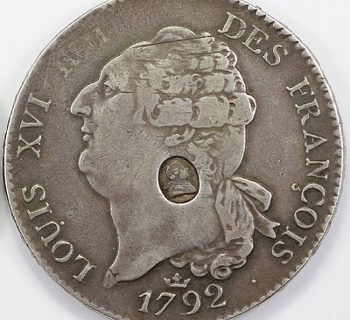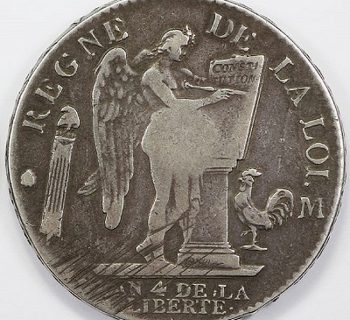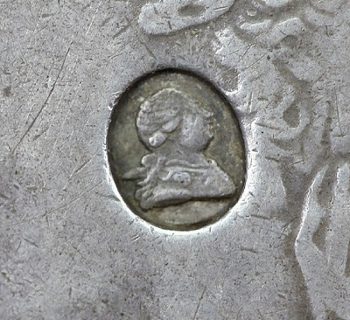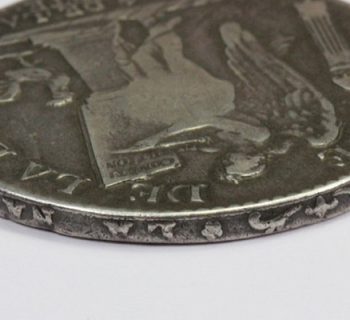High Degree of Difficulty in the making of the Unique Countermarked French Ecu of 1792 (1797)
High Degree of Difficulty in the making of the Unique Countermarked French Ecu of 1792 (1797)
It’s not often, if ever, that you can ascribe the epithet ‘unique’ to a circulation coin. That moniker is usually the preserve of pattern or proof coins struck to be studied or admired and certainly not intended to be roughly handled by the hoi polloi. However, a series of unrelated events in the late 1700s converged to see an ‘exceedingly rare’ French coin transformed into a ‘unique’ English coin of great historical importance.
After the masses revolted in 1789, the newly liberated French moved cautiously from an ‘Absolute Monarchy’ to a ‘Constitutional Monarchy,’ which is why the portrait of the neutered King Louis XVI still graced its coinage up until 1793. The King came to the throne in 1774 and although his portrait appeared on some gold, silver and copper coins during his reign it was his father’s posthumous portrait that featured on the large silver ecus right up until 1792.
The ‘Constitutional Monarchy’ proved to be short-lived and the first silver ecus struck in 1792 bore the portrait of the side-lined King Louis XVI as did the last in 1793 with both dates having either a ‘FRANCOIS’ or ‘FRANCAIS’ legend on the obverse. After the proclamation of the First Republic on September 21st, 1792 the superfluous King’s head was permanently removed from his body and from the coinage in early 1793.
In 1793, the emboldened French declared war on England who they would battle with on and off until the second defeat of Napoleon Bonaparte in 1815. This long period of conflict caused unprecedented strain on the English Treasury which continually tapped the Bank of England for loans to help fund the wars. At first, it was the drain on the Treasury’s gold reserves that was the major concern, but sterling silver was also in short supply for the much-needed circulating currency.
At the same time the Spanish 8 Reales or Dollar had entrenched itself across the globe as the major trading coin with over 38 million struck at its colonial mints in 1798 alone. As an example, during the 18th Century Spanish silver dollars outnumbered all other circulating coins in North America by a measure of four to one. The Dollar had also been reluctantly accepted by other nations as a store of wealth so much so that by 1797 the official silver bullion reserves of the Bank of England totalled £241,000 comprised entirely of Spanish dollars. However, because the fineness of the dollars fluctuated between 89.7% and 90.3 % pure, they were not considered a suitable source of silver for minting English coins which were underpinned by the 92.5% Sterling standard.
But “necessity is the mother of invention” and, in 1797 the Government decided on a short-term solution to bolster the supply of currency by co-opting the Bank of England to forward its supply of silver dollars to the Royal Mint to be countermarked with the goldsmith’s mark of King George III thus converting them to ‘coin of the realm’ and allowing their release into circulation.
This decision was inadvertently encouraged by Spain who in 1796 abandoned its alliance with England and declared war, thus giving the English the right to engage and plunder Spanish galleons of their hoards of silver dollars minted in the colonies. The Royal Mint costed the silver content in the dollars at 64 ½ shillings (or £3.225) to the troy pound and, by 31st May 1797 had used up 167,916 troy pounds to countermark 2,323,295 coins. These coins held an equivalent value of £541,529 which was £300,529 more than the official bullion reserves held by the Bank of England at the time. Such can be the side-benefits of war.
Small numbers of other silver trading coins of similar size were scattered amongst the dollars plundered from the galleons and were caught up in the mix of countermarked coins. Through the years a smattering of countermarked US dollars, Italian crown-sized coins and French ecus have surfaced and all are considered extremely rare.
But, not unlike a high-performance platform diver, the coin in Sale 70 offers a few more unbelievable twists and turns which significantly ups its ‘degree of difficulty.’ Not only is it likely to be the only surviving Countermark ‘Constitutional’ Ecu from the ‘Toulouse Mint,’ it has also been identified as having an ‘error edge’ with a segment of the lettering ‘LA NATION’ being inverted.
So, what we are looking at here is an extremely rare countermark on a scarce two-year-type coin from an obscure mint with an exceedingly rare ‘error’ edge.
What’s the chances of there being another one out there?
The host coin has been graded by PCGS as VF25 and the countermark XF detail and, bolstered by its ‘mint error’ edge and the historical intrigue of its striking it must surely be a unique offering and the equivalent of claiming Olympic Gold for the purchaser.




